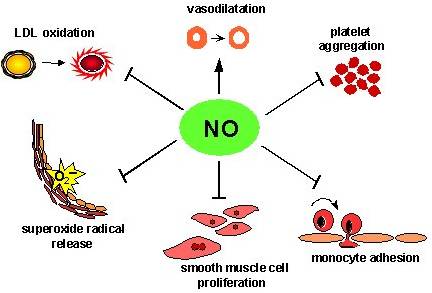

What is ADMA?
ADMA the abbreviation for asymmetric dimethylarginine and it is endogenous molecule which can be detected in human blood and urine. It shows structural homology to the amino acid L-arginine, and it acts as an inhibitor of nitric oxide (NO) synthesis. (5,6)
In fact, various studies performed in vitro and in vivo have confirmed and demonstrated that ADMA concentration-dependently inhibits NO production.(3,5) Böger RH et al. 2004 study discusses the mechanism of the modulation of NOS activity. This study describes how the inhibition of the enzyme that inactivates ADMA, dimethylarginine dimethylaminohydrolase (DDAH), thereby elevating ADMA levels and causing vasoconstriction of isolated arterial rings in vitro. (2) DDAH’s role in degradation of ADMA is the major pathway for its elimination however, a small amount is eliminated by renal excretion. (4)

Pathophysiological Role of ADMA
The vascular endothelium plays a central role in the regulation of vascular structure and function, mainly due to the formation of endothelium-derived nitric oxide (NO). NO has been named an “endogenous anti-atherogenic molecule” due to its diverse regulatory functions in vascular homeostasis. In fact, ADMA has been found to cause vasoconstriction when it is infused intraarterially. NO is formed by the enzyme NO synthetase (NOS) from the amino acid precursor L-arginine and it plays a large role within cardiovascular system. NOS activity can be down-regulated by asymmetric dimethylarginine (ADMA), an endogenous inhibitor of NOS as described above. (3,5,6)

In past studies, patients with end-stage chronic renal failure and have little or no urine output, elimination is thus blocked and as a result circulating concentrations of ADMA rise appropriately to inhibit NO synthesis. The accumulation of ADMA is thought to lead to impaired NOS synthesis as described above this is theorized to be a contributing factor to hypertension and immune dysfunction associated with chronic renal failure. (4) In addition to ADMA’s effects on vasodilation, a rise in circulating ADMA levels lead to an increased resting vascular tone. It also enhances several pro-atherogenic mechanisms including platelet aggregation and adherence of monocytes, proliferation of vascular smooth muscle cell, as well as extracellular matrix formation. (4)
The effects of ADMA on NO synthesis and NO-mediated pathophysiological processes have been described in numerous experimental studies. Moreover, elevated ADMA levels in plasma have been found in clinical studies including patients with hypercholesterolemia, hypertension, chronic heart failure, chronic renal failure and other internal disorders. Recent prospective and cross-sectional studies indicated that elevated ADMA levels are a risk factor for future cardiovascular eve
nts and total mortality. ADMA may have diagnostic relevance as a novel cardiovascular risk marker. (2,3)
Diseases Associated with Elevated ADMA Levels:
- Coronary Artery Disease
- Chronic Renal Failure and Hemodialysis Treatment
- Peripheral Arterial Occlusive Disease
- Chronic Heart Failure
- Hypertensive patients
- Diabetes Mellitus
- Lipid Disorders
- Preeclampsia
- Erectile Dysfunction
What Methods can be used to Measure ADMA?
Eagle Biosciences offers many options for researchers looking to measure ADMA:
- ADMA ELISA Assay Kit
- ADMA Ultrasensitive ELISA Assay Kit
- Mouse/Rat ADMA ELISA Assay Kit
- ADMA / Arginine ELISA Assay Kit
- SDMA ELISA Assay Kit
- Homoarginine ELISA Assay Kit
References:
- Antoniades,
C et al. “ Asymmetrical dimethylarginine regulates endothelial function in
methionine-induced but not in chronic homocystinemia in humans: effect of
oxidative stress and proinflammatory cytokines.”
Am. J. Clin. Nutr. 2006; 84: 781-788. https://ajcn.nutrition.org/content/84/4/781.full
- Böger
RH et al. “Asymmetric Dimethylarginine, an Endogenous Inhibitor of Nitric Oxide
Synthase, Explains the “l-Arginine Paradox” and Acts as a Novel Cardiovascular
Risk Factor.”
J. Nutr. 2004; 134 no. 10 2842S-2847S.https://jn.nutrition.org/content/134/10/2842S.long
- Böger
RH et al. “Asymmetric dimethylarginine: a novel risk factor for endothelial
dysfunction. Its role in hypercholesterolemia.”
Circulation 1998; 98: 1842 – 1847.https://cardiovascres.oxfordjournals.org/content/59/4/824.full.pdf+html
- Krempl
TK et al. “Elevation of asymmetric dimethylarginine (ADMA) in patients with
unstable angina and recurrent cardiovascular events.” Eur. Heart J. 2005; 26:
1846-1851.
https://eurheartj.oxfordjournals.org/content/26/18/1846.full
- Vallance
P. et al. “ Accumulation of an endogenous inhibitor of NO synthesis in chronic
renal failure”.
Lancet 1992; 339: 572
– 575.
https://www.ncbi.nlm.nih.gov/pubmed/1347093?dopt=Abstract
- Vallance
P. et al. “ Endogenous dimethyl-arginine as an inhibitor of nitric oxide
synthesis”.
J. Cardiovasc. Pharmacol.
1992; 20 (Suppl. 12): S60 – S62.
https://jn.nutrition.org/content/134/10/2842S.long











